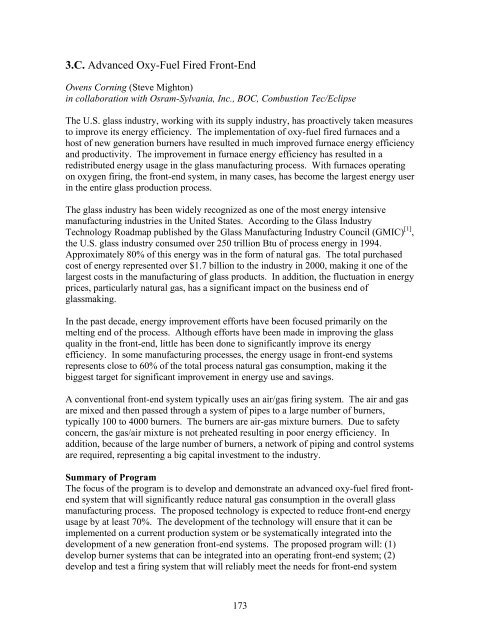Glass Melting Technology: A Technical and Economic ... - OSTI
Glass Melting Technology: A Technical and Economic ... - OSTI
Glass Melting Technology: A Technical and Economic ... - OSTI
You also want an ePaper? Increase the reach of your titles
YUMPU automatically turns print PDFs into web optimized ePapers that Google loves.
3.C. Advanced Oxy-Fuel Fired Front-End<br />
Owens Corning (Steve Mighton)<br />
in collaboration with Osram-Sylvania, Inc., BOC, Combustion Tec/Eclipse<br />
The U.S. glass industry, working with its supply industry, has proactively taken measures<br />
to improve its energy efficiency. The implementation of oxy-fuel fired furnaces <strong>and</strong> a<br />
host of new generation burners have resulted in much improved furnace energy efficiency<br />
<strong>and</strong> productivity. The improvement in furnace energy efficiency has resulted in a<br />
redistributed energy usage in the glass manufacturing process. With furnaces operating<br />
on oxygen firing, the front-end system, in many cases, has become the largest energy user<br />
in the entire glass production process.<br />
The glass industry has been widely recognized as one of the most energy intensive<br />
manufacturing industries in the United States. According to the <strong>Glass</strong> Industry<br />
<strong>Technology</strong> Roadmap published by the <strong>Glass</strong> Manufacturing Industry Council (GMIC) [1] ,<br />
the U.S. glass industry consumed over 250 trillion Btu of process energy in 1994.<br />
Approximately 80% of this energy was in the form of natural gas. The total purchased<br />
cost of energy represented over $1.7 billion to the industry in 2000, making it one of the<br />
largest costs in the manufacturing of glass products. In addition, the fluctuation in energy<br />
prices, particularly natural gas, has a significant impact on the business end of<br />
glassmaking.<br />
In the past decade, energy improvement efforts have been focused primarily on the<br />
melting end of the process. Although efforts have been made in improving the glass<br />
quality in the front-end, little has been done to significantly improve its energy<br />
efficiency. In some manufacturing processes, the energy usage in front-end systems<br />
represents close to 60% of the total process natural gas consumption, making it the<br />
biggest target for significant improvement in energy use <strong>and</strong> savings.<br />
A conventional front-end system typically uses an air/gas firing system. The air <strong>and</strong> gas<br />
are mixed <strong>and</strong> then passed through a system of pipes to a large number of burners,<br />
typically 100 to 4000 burners. The burners are air-gas mixture burners. Due to safety<br />
concern, the gas/air mixture is not preheated resulting in poor energy efficiency. In<br />
addition, because of the large number of burners, a network of piping <strong>and</strong> control systems<br />
are required, representing a big capital investment to the industry.<br />
Summary of Program<br />
The focus of the program is to develop <strong>and</strong> demonstrate an advanced oxy-fuel fired frontend<br />
system that will significantly reduce natural gas consumption in the overall glass<br />
manufacturing process. The proposed technology is expected to reduce front-end energy<br />
usage by at least 70%. The development of the technology will ensure that it can be<br />
implemented on a current production system or be systematically integrated into the<br />
development of a new generation front-end systems. The proposed program will: (1)<br />
develop burner systems that can be integrated into an operating front-end system; (2)<br />
develop <strong>and</strong> test a firing system that will reliably meet the needs for front-end system<br />
173

















